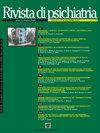Anorexia nervosa among first- and second-generation immigrant children and adolescents in Italy: treatment and clinical outcomes.
IF 1
4区 医学
Q4 PSYCHIATRY
引用次数: 0
Abstract
PURPOSE Cultural and environmental factors have frequently been implicated in the pathogenesis of Eating Disorders (ED). Although ED have been considered as "Western culture-bound syndromes", increasing rates of ED among non-Western groups are being documented. The present study aims to investigate treatment and clinical outcomes among first-generation immigrant children and adolescents (FGI) (patients born abroad) and second-generation immigrant youth (SGI, patients born in Italy) with Anorexia Nervosa (AN). METHODS The study retrospectively compares treatment, hospitalizations, traumatic past events, clinical features, and treatment outcome (improvement in percentual body-mass index - %BMI) between FGI and SGI young patients with AN (10-18 years). Correlations were adjusted for age and severity (%BMI) at presentation. Treatments and outcomes were investigated at the baseline (T0), 2 weeks (T1), one month (T2), 3 months (T3), 6 months (T4), and 12 months (T5). RESULTS Thirty-six patients (50% FGI) were enrolled. At T1 (F(1.26)=6.335, p=0.018), and at T2 (F(1.30)=18.752, p<0.001) FGI presented a significantly higher %BMI improvement than SGI. FGI required significantly less (OR=0.379, p=0.017), and shorter (F(1.32)=5.827, p=0.022) hospitalizations, when compared with SGI. CONCLUSIONS When compared to SGI, FGI with AN required fewer and shorter hospitalizations and had a better early-treatment weight outcome. Larger nationwide studies should investigate the need for and access to treatment of immigrant populations with AN.意大利第一代和第二代移民儿童和青少年的神经性厌食症:治疗和临床结果
文化和环境因素经常与饮食失调(ED)的发病机制有关。虽然ED一直被认为是“西方文化特有的综合征”,但在非西方人群中,ED的发病率正在上升。本研究旨在探讨第一代移民儿童和青少年(FGI)(出生在国外的患者)和第二代移民青年(SGI,出生在意大利的患者)神经性厌食症(AN)的治疗和临床结果。方法回顾性比较FGI和SGI年轻AN患者(10-18岁)的治疗、住院情况、创伤过去事件、临床特征和治疗结果(百分比体重指数- %BMI改善)。根据就诊时的年龄和严重程度(%BMI)调整相关性。在基线(T0)、2周(T1)、1个月(T2)、3个月(T3)、6个月(T4)和12个月(T5)对治疗和结果进行调查。结果36例患者入组,FGI占50%。T1时(F(1.26)=6.335, p=0.018), T2时(F(1.30)=18.752, p<0.001), FGI组BMI改善百分比明显高于SGI组。与SGI相比,FGI所需的住院时间显著减少(OR=0.379, p=0.017),缩短(F(1.32)=5.827, p=0.022)。结论与SGI相比,FGI合并AN所需的住院时间更少、更短,并且具有更好的早期治疗体重结果。更大规模的全国性研究应该调查移民AN患者的治疗需求和可及性。
本文章由计算机程序翻译,如有差异,请以英文原文为准。
求助全文
约1分钟内获得全文
求助全文
来源期刊

Rivista di psichiatria
医学-精神病学
CiteScore
5.00
自引率
3.70%
发文量
31
审稿时长
6-12 weeks
期刊介绍:
Gli interessi della rivista riguardano l’approfondimento delle interazioni tra mente e malattia, la validazione e la discussione dei nuovi strumenti e parametri di classificazione diagnostica, la verifica delle prospettive terapeutiche farmacologiche e non.
 求助内容:
求助内容: 应助结果提醒方式:
应助结果提醒方式:


